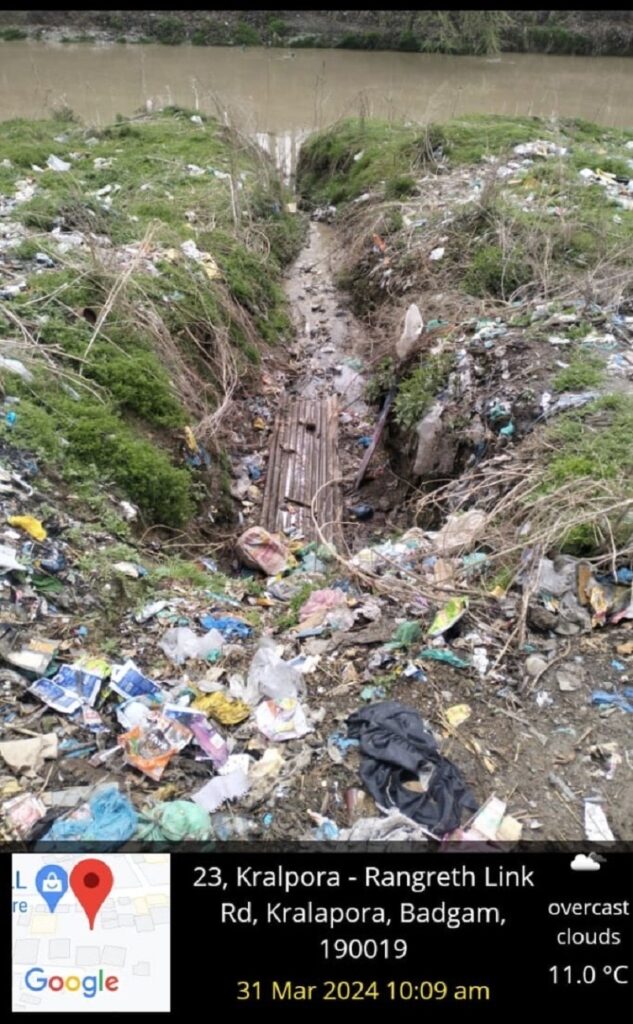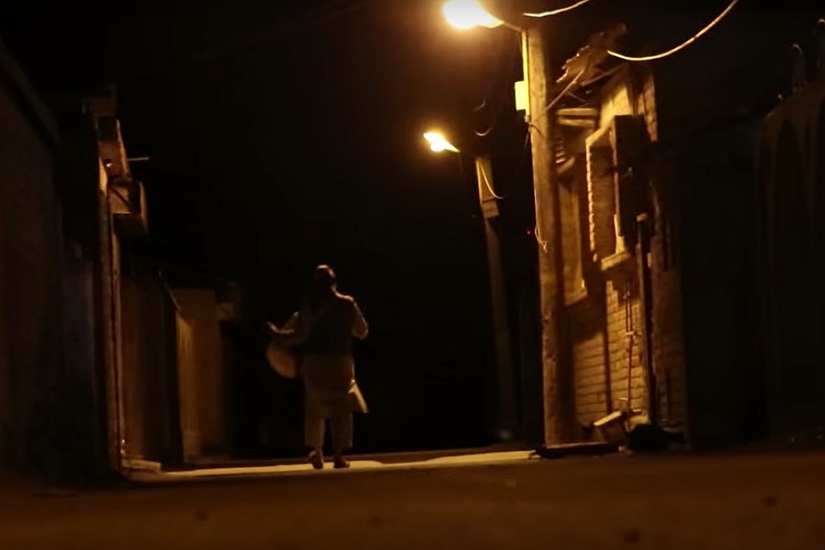
The J&K Pollution Control Committee (PCC) recently submitted a detailed water analysis report of Doodh Ganga before the National Green Tribunal-NGT. The report has been prepared by scientists of the J&K Pollution Control Committee by analyzing water samples collected from Doodh Ganga last year at various sites. The lab reports, which are in possession of this author who is also the petitioner in this case, clearly reveal that water quality in Doodh Ganga is very dangerous and isn’t even fit for bathing let alone drinking.
Ironically, the said water is supplied to more than 6 lakh people of Srinagar uptown areas.
The experts say that rise in gastrointestinal diseases and liver ailments is attributed to intake of unhygienic water supplied by the Public Health Engineering Department (PHE) also called department of Jal Shakti. Between February to July 2023 several tests have been done on water samples collected from Doodh Ganga at Nowhar, Sogam , Chadoora, Barzulla and Tengpora and the results are very scary.
In compliance to the NGTs order dated 30-05-2023 the then Principal Secretary Housing and Urban Development Department took some initiatives but that only controlled the illegal riverbed mining in Doodh Ganga to some extent but failed to control water pollution. Despite the meeting convened by Principal Secretary HUDD J&K Govt on 15-06-2023 and 17-07-2023 wherein he directed all the stakeholders to take remedial measures vis-a-vis sewage, managing solid waste, legacy waste along with banks of Doodh Ganga and Mamath Kul, not much work was done by the respective Govt institutions.
Sanitation Drive on Doodh Ganga
The Municipal Committee Chadoora, Srinagar Municipal Corporation and District Administration Budgam undertook sanitation drives on the banks of Doodh Ganga between May 27th to June 1st week on different dates. The legacy waste was cleared near Kralpora bridge by SMC sanitation workers on the orders of the then Commissioner SMC Athar Amir Khan , but no followup work was taken up later on. One can see heaps of waste dumped there again and liquid waste continues to enter Doodh Ganga at Kralpora even near the area where-from water is pumped up to the filtration plant. This is quite dangerous.
MC Chadoora took up sanitation work in Chadoora town and other areas as well but the areas which are outside the municipal limits continue to be filled with trash and open drains enter Doodh Ganga from Branwar to Kralpora at least 50 to 60 places. For the last 9 months no regular sanitation drives to clear solid waste or legacy waste around the banks of Doodh Ganga banks is being taken up. Only in Chadoora town and SMC municipality jurisdiction the regular sanitation work is done , rest of the areas are choked with trash especially in the rural areas falling under blocks of Surasyar, Chadoora and BK Pora in district Budgam. Huge amount of solid waste has accumulated on the banks of Doodh Ganga at Borwah, Sogam, Hanjugund, Wathoora, Stadium Colony, Chinar Colony Wathoora, Kralpora, Mouchwa and other places. It is an irony that the liquid waste continues to enter Doodh Ganga at multiple locations from Brenwar Budgam to Tengpora Srinagar especially at Branwar , Surasyar, Nowhar, Dadompora, Borwah, Zuhama, Sogam, Chadoora town, Hanjigund, Wathoora, Kralpora, Mouchwa.
Unfortunately, the same contaminated water as explained above is lifted at Doodh Ganga water supply scheme Kralpora and supplied to more than 6 lakhs population of Srinagar District and some parts of Budgam as well.
PCC water analysis report
The Pollution Control Committee has submitted the water quality profile of Doodh Ganga before the National Green Tribunal (NGT). The water sampling of Doodh Ganga was done between January to July 2023 at multiple locations which clearly reveals that the water quality at Chadoora Town and at Tengpora Bridge Srinagar is not fit for bathing leave aside drinking this water ? The same water is lifted at Kralpora Doodh Ganga Water Supply Scheme which is located 6 km Chadoora downstream and then supplied to 6 lakh population of Srinagar and Budgam after chlorination.
How can chlorination make this dirty water fit for consumption? The PCC’s water analysis report says that water at Chadoora town and its downstream contains ammoniacal nitrogen, high concentrated sulphates plus calcium and magnesium.
The water quality report submitted by J&K Pollution Control Committee to NGT clearly indicates that primary water quality in Doodh Ganga is bad as per the criteria for bathing water which is published in the Gazette of India on September 25th year 2000. As per the said criteria, the recommended fecal coliform count in bathing water is 500 colony-forming units (CFU) per milliliter, with a maximum permissible limit of 2500 CFU/ml. These limits are established to accommodate variations in environmental conditions, such as seasonal changes and fluctuations in flow conditions. However, for drinking purposes, the acceptable fecal coliform count is zero, as specified by the Bureau of Indian Standards (BIS) in IS 10500:2012 (PM/ 10500/ 1 October 2020).
It is worthwhile to mention that the fecal coliform counts at all sampling sites exceed the acceptable limits. Specifically the water quality at Chadoora exceeds the desirable limit for bathing water by nearly three times, indicating a significant level of contamination. Additionally, at Tengpora and Old Barzulla sites, the contamination levels are exceptionally high, being nearly 20000 CFU/ml.
Grave Health Implications
The health implications of such contamination are very serious and the officials at the helm of affairs should be taken to task. Even as huge funds have been provided to J&K under the Jal Jeevan Mission, the same are utilized only to procure water pipes as muddy water, dirty water mixed with fecal waste continues to be supplied to people in areas of Srinagar uptown like Hyderpora, Pirbagh, Humhama, Sanat Nagar, Rawalpora, Rangreth, Gogoland , Chanapora, Nowgam, Bagh-e-Mehtab and other places.
Water with fecal coliform levels as high as 20,000 CFU/ml poses a severe risk of waterborne diseases and infections to anyone who comes into contact with it. Consumption of contaminated water can lead to gastrointestinal illnesses, and potentially severe conditions in vulnerable populations. Although other parameters like DO, BOD, TDS may fall within the permissible BIS levels, the extremely high fecal coliform count alone deems the water unsuitable for consumption/bathing at all locations’.
Rs 35 Cr penalty on Govt
During several hearings and through written affidavits as well the Housing and Urban Development Department -HUDD J&K time and again gave assurance to the National Green Tribunal-NGT that the sewage treatment plants-STPs would be setup on the banks of Doodh Ganga at different areas but that hasn’t been done till date from 2022 ? The NGT imposed Rs 3 crore interim penalty on SMC , Directorate of ULB Kashmir and Mining Department in 2022. Then last year Rs 32 crore penalty was again imposed which is to be utilized for Doodh Ganga STPs but till date the STPs have not been set up anywhere.
Drainage of polluted water by SMC
In addition, more than half a dozen water pumping stations have been set up by Srinagar Municipal Corporation at Chanapora, Natipora, Pamposh Colony, Barzullah, Bulbul Bagh, Tengpora which flush out untreated sewage and other toxic liquid waste into Doodh Ganga. This matter has been brought into the notice of the NGT and Srinagar Municipal Corporation was penalized as well but till date these pump stations are constantly operating and causing environmental disaster which openly violates the Water Prevention and Control of Pollution Act 1974. It is worth mentioning that these pump stations were funded by World Bank for flood mitigation in Srinagar City and were supposed to drain out storm water but these were connected with sewer lines that openly violates the Water Act 1974.
- Views expressed in the article are the author’s own and do not necessarily represent the editorial stance of Kashmir Observer
Follow this link to join our WhatsApp group: Join Now
Be Part of Quality Journalism |
Quality journalism takes a lot of time, money and hard work to produce and despite all the hardships we still do it. Our reporters and editors are working overtime in Kashmir and beyond to cover what you care about, break big stories, and expose injustices that can change lives. Today more people are reading Kashmir Observer than ever, but only a handful are paying while advertising revenues are falling fast. |
| ACT NOW |
| MONTHLY | Rs 100 | |
| YEARLY | Rs 1000 | |
| LIFETIME | Rs 10000 | |






